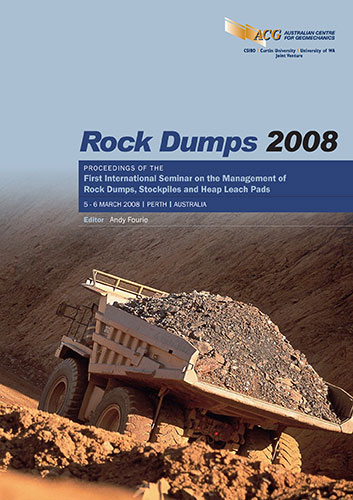Challenges Faced by Dexing Copper Mine ― A Case Study of Dump Leaching in China

|
Authors: Yin, SH; Wu, AX; Wang, HJ; Zhou, B Paper is not available for download Contact Us |
DOI https://doi.org/10.36487/ACG_repo/802_16
Cite As:
Yin, SH, Wu, AX, Wang, HJ & Zhou, B 2008, 'Challenges Faced by Dexing Copper Mine ― A Case Study of Dump Leaching in China', in AB Fourie (ed.), Rock Dumps 2008: Proceedings of the First International Seminar on the Management of Rock Dumps, Stockpiles and Heap Leach Pads, Australian Centre for Geomechanics, Perth, pp. 179-191, https://doi.org/10.36487/ACG_repo/802_16
Abstract:
Dexing Copper Deposit, located in Jiangxi province, China, is one of the largest porphyry copper deposits in the world, the copper content of which exceeds eight million tonnes. Fine hundred million tonnes of waste rock with grades between 0.1 and 0.3 will be produced during open pit mining of Dexing. The amount of copper metal is 1.2 million tonnes. In order to extract copper metal from those secondary resources and resolve the environmental problems caused by acidic water and heavy metals released from the waste rock dump, a dump bioleaching-solvent extraction-electrowinning plant was designed based on a series of experimental investigations. Presently, there are a number of challenges faced by this plant, such as low recovery efficiency, low Cu2+ concentration and limited production. The investigation shows that the low- grade of the dump, refractoriness of chalcopyrite, small sprinkling area, leakage of pad, small bacteria population, low dump permeability are the main factors that contribute to the challenges. Several measures were exercised by the plant, such as separating ores from rocks, stripping and loosening the surface layer of dump, loosening the entire dump by use of explosives. Besides those challenges, stability of the high and steep slope of the dump is a hidden danger to which much attention is not paid. The height of the dump exceeds 70 m, and the inclination of the slope is 55°. The failure of dump could result in a dangerous disaster. Mechanical properties of the waste rock before and after leaching were investigated. The result shows that the normal stress, shear strength and cohesion decreased sharply during the leaching process.
References:
Barrett, J. and Hughes, M.N. (1993) Metal Extraction by Bacterial Oxidation of Minerals. Ellis Horwook, New York.
Bartlett, R. (1998) Solution Mining: Leaching and Fluid Recovery of Material, Second edition. Gordon and Breach
Science Publishers, The Netherlands.
Mousavi, S.M., Jafari, A., Yaghmaei, S., Vossoughi, M. and Sarkomaa, P. (2006) Computer simulation of fluid motion
in a porous bed using a volume of fluid method: Application in heap leaching. Minerals Engineering, pp. 1077-
1083.
Rodriguez, Y., Ballester, A., Blazquez, M.L., Gonzalez, F. and Munoz, J.A. (2003) New information on the
chalcopyrite bioleaching mechanism at low and high temperature. Hydrometallurgy 71, pp. 47-56.
Thiel, R. and Smith, M.E. (2004) State of the practice review of heap pad design issues. Geotextiles and
Geomembrances 22, pp. 555-568.
Veglio, F., Trifoni, M., Pagnanelli, F. and Toro, L. (2001) Shrinking core model with variable activation energy: a
kinetic model of manganiferous ore leaching with sulphuric acid and lactose. Hydrometallurgy 60, pp. 167-179.
Watling, H.R. (2006) The bioleaching of sulphide minerals with emphasis on copper sulphides - A review.
Hydrometallurgy 84, pp. 81-108.
Wu, A.X., Yin, S.H., Yang, B.H., Wang, J. and Qiu, G.Z. (2007) Study on preferential flow in dump leaching of low-
grade ores. Hydrometallurgy 87, pp. 124-132.
Yang, S.R., Xie, J.Y., Qiu, G.Z. and Hu, Y.H. (2002) Research and application of bioleaching and biooxidation
technologies in China. Minerals Engineering 15, pp. 361-363.
Young, C.A., Alfantazi, A.M., Anderson, C.G., Dreiginger, D.B., Harris, B. and James, A. (2003) Hydrometallurgy
2003. Fifth International Conference in Honor of Professor Ian Ritchie-Volume 1: Leaching and Solution
Purification. TMS (The Minerals, Metals & Materials Society), pp. 289-314.
Hydrology of Rock Dumps
Rock Dumps 2008, Perth, Australia 191
© Copyright 2025, Australian Centre for Geomechanics (ACG), The University of Western Australia. All rights reserved.
View copyright/legal information
Please direct any queries or error reports to repository-acg@uwa.edu.au
View copyright/legal information
Please direct any queries or error reports to repository-acg@uwa.edu.au